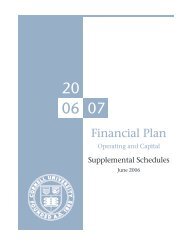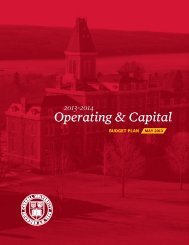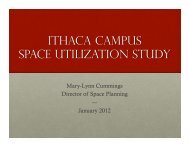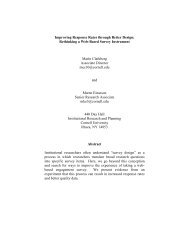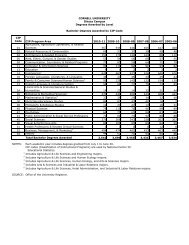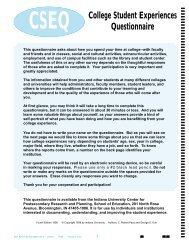Financial Plan - Cornell University Division of Budget & Planning
Financial Plan - Cornell University Division of Budget & Planning
Financial Plan - Cornell University Division of Budget & Planning
You also want an ePaper? Increase the reach of your titles
YUMPU automatically turns print PDFs into web optimized ePapers that Google loves.
Tuition, <strong>Financial</strong> Aid & Endowmentreduced <strong>Cornell</strong>’s funding. This methodology also providedno inflation for <strong>Cornell</strong>’s land-grant mission andits provision <strong>of</strong> instruction for contract college studentsin endowed Ithaca colleges (so-called “accessoryinstruction”). Beginning in 2006-07, <strong>Cornell</strong>’s overallstate operating support—while still flowing throughSUNY—has been largely separated from SUNY’s regularcampus resource allocation process. Within that total,the portion <strong>of</strong> state operating support attributableto land-grant activities is provided through discrete,line-item funding in the governor’s executive budget.This partition appropriately recognizes that <strong>Cornell</strong>’sland-grant responsibilities as well as the organizationaland financial structures associated with instructionalactivities are unique and should not be commingledwith other SUNY campus resource allocations.Since 1970-71, there has been nominal growth ingovernment appropriations for the contract colleges,as federal and state funding has expanded at an averageannual rate <strong>of</strong> 4.1 percent. Unfortunately, thisgrowth has not maintained its purchasing power, andgovernment appropriations have declined from $206Inflation-Adjusted Dollars in MillionsFederally Sponsored ResearchExpenditures – <strong>Cornell</strong> <strong>University</strong>(in inflation-adjusted, 2006-07 dollars)$300$250$200$150$100$50Ithaca CampusMedical College$041 46 51 56 61 66 71 76 81 86 91 96 01 06Fiscal Yearmillion to $171 million, in inflation-adjusted terms,over the same period. Appropriations that funded 67percent <strong>of</strong> the contract colleges’ operating budget in1970-71 now support 30 percent <strong>of</strong> that total. Otherrevenues—tuition and fees, grants and contracts, gifts,investment income, and sales and services <strong>of</strong> academicdepartments—have together supplanted governmentappropriations as the major sources <strong>of</strong> operatingsupport. The gradual decline in state funding for thecontract colleges—transforming them from state-supportedto state-assisted—has been an important factorin the <strong>of</strong>fsetting increase in contract college tuitiondiscussed and illustrated on page 15.Grants and ContractsWhile <strong>Cornell</strong>’s faculty have engaged in scholarshipand have carried out investigatory projects fromthe university’s founding, the concept <strong>of</strong> externallyfunded research did not develop until the first part <strong>of</strong>the twentieth century, when commercial firms beganto underwrite graduate study by providing “industrialfellowships.” 17 It was not until World War II, however,that substantial external funding was provided to<strong>Cornell</strong> and other universities in the form <strong>of</strong> researchgrants and contracts. As the graph at left shows, thevolume <strong>of</strong> this support expanded rapidly at <strong>Cornell</strong>,and the university’s federal funding for research totaled$382.9 million in 2006-07, while overall researchexpenditures—federal, state, and local government;corporate; foundation; private donor; and institutionalfunding—reached $659.4 million in the same fiscalyear. Inflation-adjusted expenditures <strong>of</strong> federally sponsoredresearch on the Ithaca campus expanded rapidlyfrom the early 1960’s through the mid-1980’s, thenstalled for over a decade before increasing again inthe twenty-first century. Federally sponsored researchexpenditures at the Joan and Sanford I. Weill Medical17 “Thanks to [Herbert H.] Whetzel’s initiative, industrialfellowships were established at <strong>Cornell</strong>, among the first inAmerica. He proposed to the Niagara Sprayer Company<strong>of</strong> Middleport, New York, that it support investigations inthe value <strong>of</strong> lime-sulfur solution as a spray for apple scab.The company responded in 1909 and apparently made itsfortune from the results. Thus the system began by which amanufacturer pays for a graduate student to study a problemwhich may result in pr<strong>of</strong>it for the manufacturer and a doctoratefor the student.” Bishop, Morris, A History <strong>of</strong> <strong>Cornell</strong>.Ithaca: <strong>Cornell</strong> <strong>University</strong> Press, 1962.20




